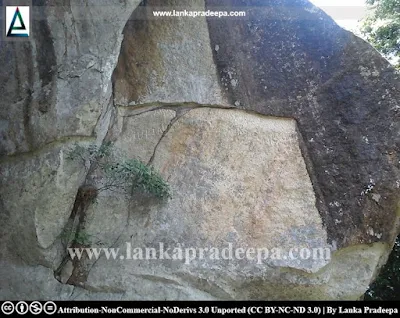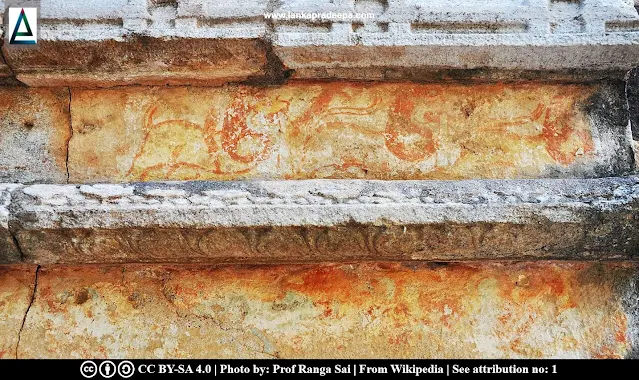
Kantaka Cetiya, also known as Kanthaka Dagoba/Chethiya (Sinhala: මිහින්තලය කණ්ඨක චේතිය), is a Stupa located in the ancient Buddhist complex monastery of Mihintale, Anuradhapura District, Sri Lanka. The Stupa is notable as it has the best and the most ancient ornamental frontispieces (Vahalkada) found in the country (Jayasuriya, 2016; Wikramagamage, 2004).
History

This Stupa is believed to have been constructed during or soon after the reign of King Devanampiyatissa [(247-207 B.C.) Nicholas, 1963]. According to Mahawamsa, Devanampiya Tissa had refurbished sixty-eight caves (present Ataseta Len)
in the neighbourhood of the Kantaka Cetiya for the use of the monks
headed by Arhat Mahinda. During the reign of King Lanja Tissa
(119-109 B.C.), a Chatra stone (a stone umbrella) had been added to the
Stupa (Nicholas, 1963; Wikramagamage, 2004). King Mahadhathika Mahanaga (9-21 A.D.) held a great festival at this site which became known as the Giribhanda festival (Nicholas, 1963). In the 8th century A.D., King Udaya I (797-801 A.D.) restored Giribhanda Viharaya (Nicholas, 1963). The Mihintale Slab Inscriptions of Mahinda IV have mentioned this Stupa as Kiribandpavu Dagoba (Nicholas, 1963; Wikramagamage, 2004).
Inscriptions
One of the two inscriptions mentioning the name of King Mahadhathika Mahanaga (9-21 A.D.) at Mihintale is found on a rock surface near the Kantaka Stupa (Sirisoma, 1990). This inscription records the donations made to the Kataca Ceta (Kantaka Cetiya) by two kings, King Tisa (Bhathika Tissa) and King Naka [(Mahadhathika Mahanaga) Sirisoma, 1990]. From the Stupa name given in this inscription, it has been believed that the Stupa now called Kantaka Cetiya is the same as the Kantaka Cetiya that is mentioned in the chronicle Mahawamsa. Kantaka Cetiya Rock Inscription
Kantaka Cetiya Rock InscriptionScripts: Later Brahmi
Language: Old Sinhala
Content: The Great King Bhatikatissa gave the
revenues from the land and water taxes of the Kabavika tank to the Kantaka Cetiya. The great
King Mahadathika Mahanaga having purchased the Balayatha-Gamakavi tank gave to the Kantaka
Cetiya the revenues from the land and water
taxes.
Reference: The information board at the site
by the Department of Archaeology and Ministry
of National Heritage and Cultural Affairs

Kantaka Cetiya Cave Inscription
Period: 3rd Century B.C.-1st Century A.D.
Scripts: Early Brahmi
Language: Old Sinhala
Transcript: Parumaka Naga puta Asaliya
lene agata anagata catudisika sagaye
Translation: The cave of Asali, son of
the chief Naga is donated to the Sangha
of the four quarters, present and absent
Reference: Paranavitana, S., 1970; The
information board at the site by the
Department of Archaeology and Ministry
of National Heritage and Cultural Affairs
Stupa
Kantaka Cetiya Stupa is 21 m in height and has a peripheral length of about 127.5 m (Wikramagamage, 2004). The stone works of Kantaka Cetiya are dated to about the beginning of
the Christian era. Two terracotta figures belonging to the 5th century
have also been found on the temple premises (Paranavitana, 1950).
Frontispieces

Frontispieces which are at the cardinal points of the Stupa are formed of horizontal bands separated by string courses (left photograph). The flank of the frontispieces is adorned with limestone stelae which contain the oldest specimens of the plastic art in the country (Paranavitana, 1950). According to Wikramagamage, these frontispieces may belong to the 1st century A.D. or to a period even earlier (Wikramagamage, 2004).
As found in the frontispieces at Abhayagiri, Jetavana, and Ruwanweliseya Stupas, some remains of ancient paintings have also been found in the frontispieces of Kantaka Cetiya (Wikramagamage, 2004).
Attribution
References
1) Jayasuriya, E., 2016. A guide to the Cultural Triangle of Sri Lanka. Central Cultural Fund. ISBN: 978-955-613-312-7. p.59.
2) Nicholas, C. W., 1963. Historical topography of ancient and medieval Ceylon. Journal of the Ceylon Branch of the Royal Asiatic Society, New Series (Vol VI). Special Number: Colombo. Royal Asiatic Society (Ceylon Branch). p.163.
2) Nicholas, C. W., 1963. Historical topography of ancient and medieval Ceylon. Journal of the Ceylon Branch of the Royal Asiatic Society, New Series (Vol VI). Special Number: Colombo. Royal Asiatic Society (Ceylon Branch). p.163.
3) Paranavitana, S., 1950. Sinhalese Art and Culture. Journal of the Royal Society of Arts, 98(4822), pp.588-605.
4) Paranavitana, S., 1970. Inscription of Ceylon: Volume I: Early Brahmi Inscriptions. Department of Archaeology Ceylon. p.2.
5) Sirisoma, M.H.; [Wijesekera, N (Editor in chief)], 1990. Brahmi inscriptions of Sri Lanka from 3rd century B.C. to 65 A.D. Archaeological department centenary (1890-1990): Inscriptions. Commissioner of Archaeology. pp.28, 35.
4) Paranavitana, S., 1970. Inscription of Ceylon: Volume I: Early Brahmi Inscriptions. Department of Archaeology Ceylon. p.2.
5) Sirisoma, M.H.; [Wijesekera, N (Editor in chief)], 1990. Brahmi inscriptions of Sri Lanka from 3rd century B.C. to 65 A.D. Archaeological department centenary (1890-1990): Inscriptions. Commissioner of Archaeology. pp.28, 35.
6) Wikramagamage, C., 2004. Heritage of Rajarata: Major natural, cultural
and historic sites. Colombo. Central Bank of Sri Lanka. pp.159-164.
Explore Other Nearby Attractions
Location Map (Google)
This page was last updated on 14 January 2023

